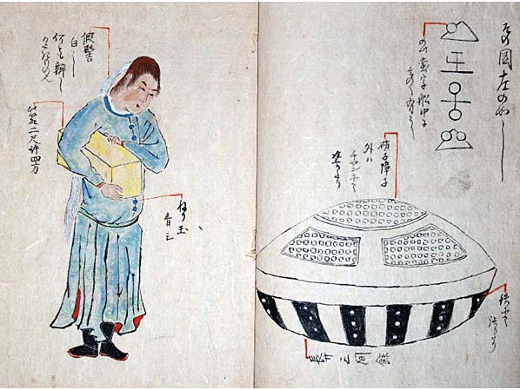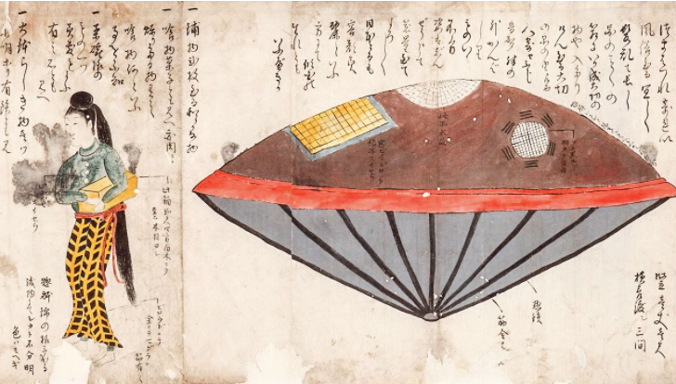
Utsuro-bune (“hollow ship”) was the name given by villagers in northeast Japan to a strange iron-clad watercraft that washed up on February 22, 1803, carrying a young woman with pale features and shoulder length red hair who spoke an incomprehensible language.
Three 19th century accounts of the incident concurred that the circular boat, 3.5 meters tall and 5.5 meters in diameter, was painted red and inscribed with unknown symbols. The hull, with clear glass windows, contained a living area with food, water, and luxurious furnishings. The villagers found the woman’s features strange and could not make themselves understood to her. Rather than report her to local authorities, they cast her adrift, and she was never seen again. A Japanese historian who studied the incident in the early 20th century suggested that the woman came from nearby Russia and might have been set to sea as punishment for adultery.¹
In 1964 science writer Morihiro Saito was struck the similarity of reports of “flying saucers, and the “hollow ship” of the Utsuro-bune legend.² The story of “The Foreign Woman in the Hollow Ship” was first told in Toen Shosetsu (Tales of the Rabbit Garden), an 1825 collection of fantastic tales. A color illustration in the book shows a spherical vessel, not unlike the Saturn-shaped objects of UFO legend.³ In the 1960s Japanese novelists reimagined the Utsuro-bune tale as an alien intrusion provoking criticism from scholars.⁴
In 1987 Masuro Mori reinterpreted the Utsuro-bune story for Western readers in the Fortean Times, a British monthly devoted to anomalous phenomena. What the historical sources described as a watercraft was actually a spacecraft, Mori argued. The young woman, he wrote, was a “female alien.”⁵ In the schema of astronomer Allen Hynek, the utsuro-bune story was classified as “CE-V (Close Encounter V) Voluntary bilateral contact between humans and extraterrestrials.”⁶
After examining numerous historical texts and illustrations, Kazuo Tanaka, a professor of computer engineering, concluded the “hollow craft” was not of extraterrestrial origin. While the resemblance of the Utsuro-bune to modern reports of “flying saucers” was striking, Tanaka said that the utsuro-bune was not reported to have flown or moved on its own, nor did it display extraordinary technologies. Iron hulls and glass windows, he noted, were in use at the time, though not in that part of Japan. Tanaka concluded the tale of the utsuro-bune was a true story of a human sea-born visitor that was embellished by the cultural imagination of an insular community.⁷
